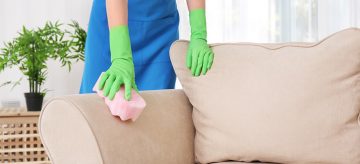Got a lovely bouquet of gorgeous-smelling flowers? You rush to put them in a vase, of course, only to find on the following day that some pollen has escaped and stained your sofa or carpet. Tulips, fuschias, orchids can all readily become the culprits behind the colourful mess on nearby surfaces or the unsightly stain on your white shirt.
Removing lily stains from fabrics is not as hard as you might think. And as long as you stay well away from the hasty idea to wet a cloth and start rubbing the stain, you will have every chance of succeeding.
So, if you:
- Have found pollen has stained your clothes or carpet;
- Wonder how to remove lily pollen;
- Want to avoid a permanent stain.
Then this article is for you!
How to remove lily pollen from clothes and fabrics
Whether some pollen drops on a cushion while you are unwrapping a bunch of lilies or you accidentally touch the flowers with your sleeve, the orangy powdered hue will inevitably set in and tinge the fabric, leaving you with a stain to deal with.
So, here’s a list of things that you can do to remove lily pollen stain:
- Shake.
Clothes, pillowcases, linen and throw-overs can be shaken energetically until most of the dust falls off. You can also use a soft brush and try to stoke off the pollen without rubbing it.
- Use tape to lift the pollen.
Gently lift the coloured powder from the fabric with strong sellotape or velcro tape.
- Rinse and soak the clothing.
Rinse your garment under cold water. After removing as much of the pollen stain as possible, soak the clothing in cold water for 30 minutes.
- Put the item in the sunlight.
Place the piece of clothing or fabric in direct sunlight for two to three hours. As a result of absorbing natural UV light from the sun, the carotenoids that make up pollen’s organic pigment undergo a process known as photodegradation and fade away.
- Get a UV torch.
Have a go at treating small pollen stains with a UV torch if the day is rather overcast. The phytochemicals will decompose and the stain will fade away.
- Pretreat with an enzyme cleaner.
Enzyme spot cleaners are designed to break down biological substances, so they are especially suitable for use on organic stains.
- Wash the fabric.
After pretreatment with the appropriate stain removal, you can wash the piece of cloth in the washing machine at a high temperature. Then, use the sun again to naturally bleach the mark, if any, and make it disappear for good. for good.
- Buy a dry cleaning kit.
This method is your only solution if the stubborn lily stain has damaged a piece of clothing that can be only dry-cleaned. Follow carefully the manufacturer’s instructions but if unhappy with the result you can turn to a professional dry cleaning service.
How to get lily stains out of carpet
As you’ll find it tricky to soak your fitted carpet or air it under the sun, you need to use a slightly different pollen removal approach if your floor covering ends up with a lily stain. The same goes for upholstery fabric that can’t be removed from your furniture and put in the washer.
- Vacuum.
Use a vacuum cleaner without any attachments to pull away from the pollen dust. Make sure that the tube doesn’t touch the carpet by holding it half an inch away from the surface. If powerful enough, the machine should suck most of the lily pollen. - Sticky tape.
Apply the adhesive tape method and carefully remove any remaining fine dust. Skip this step if the mishap has occurred on a deep pile carpet or shaggy rug. Shag rugs require special attention. To learn more about how to maintain such carpets, read our helpful post on how to clean a shag and wool rug. - Hydrogen peroxide.
Depending on the material your carpet or upholstery is made of, you may achieve some success if you blot the lily stain with a cloth, dipped in a 3% hydrogen peroxide solution, and diluted with water (50/50). The method is generally safe to use on synthetic colourfast fabrics. Still, test on an inconspicuous patch, first. The oxygen part of the compound substance helps the degradation of organic dyes and stains through the process of oxidation. - Soda crystals.
Soda crystals, also known as washing soda, can help remove lily pollen stains too. The compound will absorb the essential oil pigments of the pollen. To treat the stain, dampen it with some liquid soda crystals and pat dry with a clean white cloth. Again, test the fabric for colour fastness, first. - Enzyme cleaner.
Use an enzyme stain removal or a laundry detergent to treat the pollen mess. Remember, however, that Oriental rugs and other types of naturally dyed carpets may be damaged as the enzyme cleaner will break down the plant-based dyes, too. In addition, this solution is effective against protein-based stains on carpets, such as ones from milk or vomit. - Isopropyl alcohol.
A strong solvent, such as isopropyl alcohol which is capable of removing paint stains and able to dissolve wax on the carpet, will also do the trick of disintegrating the lily pollen that has stained your beige sofa or rug. But along with the removal of the orange lily stain, you may also inadvertently ruin your furniture or flooring, so maybe it’s better if you leave this method alone.
Things to avoid when removing lily pollen stains
Don’t touch lily pollen stain
Kids do this in anticipation to see what will happen. So, restrain your innate urge to touch the vibrant dust and check if it tints your index finger. Your natural skin oils will worsen the situation by turning the dry matter into a smudge.
Don’t dab the stain
Don’t reach for the kitchen roll to dab lily stain! You will only embed the pollen deeper into the fabric. The adhesive material that encases the pollen grains, called pollenkitt, will stick to the textile fibre if you try to blot the stain out with some paper.
Do not wipe the lily pollen stain
It is not a good idea to wipe lily pollen. Regardless of what you use to wipe the yellow or orange dust, it will just “help” you spread the lily stain on the carpet, upholstery or garment. It will be even worse if you use wet wipes.
Water won’t help, either!
Using water may be helpful at a later stage but if you rush to wet the pollen stain as the first line of action, you will find that it will spread. Although pollen is not necessarily water-soluble, the powder mixed with water will easily form a much larger splotch.
Count on professionals to remove lily pollen stains
To avoid doing more damage than good, always check the label on both the chemical solution you are about to use and the item you intend to treat. And if you feel insecure handling the stains on your own, you can always contact a professional carpet cleaning service.
After all, it is much safer to leave the task of cleaning your carpet or removing tricky stains from your upholstery to the experts. Equipped with everything necessary, the professional cleaners will treat your items with attention and care and will successfully remove lily pollen stains.
Professional carpet cleaning services is available near you.
Get in touch with the professionals.
Takeaways
- Touching, dabbing or rubbing lily pollen stain should be avoided, as it will make it worse.
- Do not use water to wash off the dust at first.
- Shaking or taping away lily pollen is effective.
- Sunlight helps loosen the pollen dust and remove the stain.
- You can wash the garment in the washing machine once the pollen stain has been properly pre-treated.
- You can vacuum or tape the dust off a carpet.
- If using chemicals, always check the label to avoid damage to the fabric.
***
Did you find this article helpful? Do you have any tips on getting rid of lily pollen stains? Let us know in the comments!
Image source: shutterstock / Nataliia Krasnogor
Enjoyed this article? Share with your friends!













